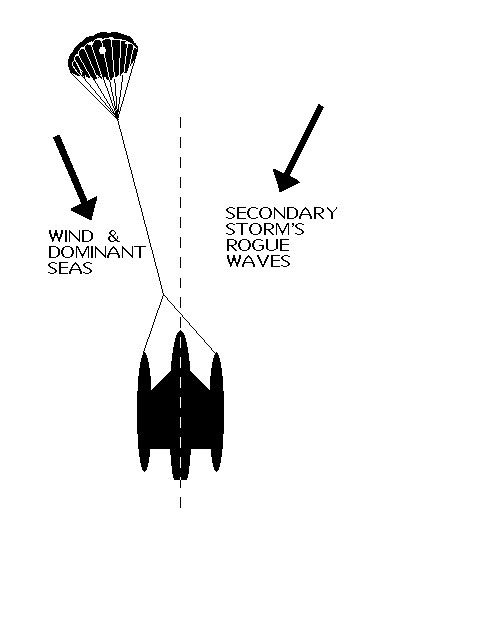S/C-6A
Catamaran, Crowther
43' x 25' x 7.5 Tons
18-Ft. Dia. Sea Anchor
Force 9 Conditions
File S/C-6A, obtained from Josh Tofield, Tucson, AZ. - Vessel name Ariel, hailing port San Diego, catamaran, designed by Lock Crowther, LOA 43' x Beam 25' x Draft 3' 3" x 7.5 Tons - Sea anchor: 18-ft. Diameter Para-Tech on 250' x 3/4" nylon three strand tether and bridle arms of 75' each, with 5/8" galvanized swivel - Full trip line - Deployed in a tropical depression in deep water about 400 miles SE of Cabo San Lucas, Mexico, with winds of 45-60 knots and seas of 18 ft. - Vessel's bow yawed 10° - Drift was 2 n.m. during 20 hours at sea anchor (confirmed by GPS).
Several weeks after Ariel left San Diego for points south she ran into an unforecast loop of ITCZ - Inter Tropical Convergence Zone - at 21° 09' North, 106° 52' West. In his book, Weather For The Mariner, William J. Kotsch has this to say about the phenomena (Naval Institute Press, reproduced by permission):
"The ITCZ is usually characterized by strong, ascending air currents, a great deal of cloudiness, and frequent heavy showers and thunderstorms. The intensity does, however, vary greatly. Sometimes the ITCZ looks like a tremendous wall of black clouds, with the top extending to 55,000 feet and higher.... The width of the ITCZ varies from about 20 to 150 nautical miles, and as a general rule, the narrower the zone (i.e., the greater the convergence), the more intense is the weather associated with it. When the ITCZ is near the equator, only small and weak cyclonic circulations can develop within it. But when it migrates away from the equator (at least five degrees or more), the influence of the earth's rotation becomes great enough to transfer sufficient "spin" to the converging air currents to permit tropical cyclones, hurricanes, and typhoons to develop."
One really needs a chart of Mexican waters to appreciate the value of a parachute sea anchor in tight quarters. Ariel was about 100 miles off the Mexican coast proper, with the rocky islands known as Tres Marias to her lee. The crew consisted of owner Josh Tofield, his wife, and two small children. Tofield deployed an 18-ft. diameter Para-Tech sea anchor and "anchored" Ariel to the surface of the sea.
Tres Marias is a Mexican prison compound. There is a 20-mile forbidden zone around it and pleasure boats have been known to be rammed by gunboats for intruding into the zone. It being dark, and apprehensive about getting too close to the islands, Josh Tofield kept a close eye on the GPS readings. Incredibly, he found that Ariel drifted no more than 2 nautical miles in the 20 hours that she was tethered to the sea anchor. Transcript:
Only 100 miles from Puerto Vallarta and with the Islas Tres Marias in our lee we got caught in a brief but fierce (unpredicted by WX or WXFAX) loop of ITCZ convection sucked up to our latitude. Winds of 45 knots sustained, gusts to 60 for 6-8 hours, with 30-35 knots sustained for 6-8 hours before and after. As long as the wind was blowing from the SE the seas were highest - but also most comfortable, as our catamaran rocked up and down in 18-ft. maximum seas, with 3-ft. breaking tops, and almost no side to side [yawing] motion. However, as the wind veered, large cross swell came under and slammed bridge & deck viciously - but no damage and no excess heeling.
My alternative would have been to run off to the West - which we could have done - but I didn't want to as we would have been blown all the way to Cabo before the wind subsided.
Only problem was the trip line. Perhaps I tied it on wrong to its small swivel, but it fouled fender severely and pulling in required anchor windlass and much bad language!

This is one of numerous files in which boats had problems with fouled up trip lines. Yet another reminder that FULL trip lines should be kept fairly taut at all times (see Fig. 39 and review last paragraph of file S/T-7). Also, the problem relating to cross swells mentioned by Tofield can in most instances be lessened by adjusting the lengths of the bridle arms on multihulls. By shortening one bridle arm and lengthening the other (Fig. 41) it is possible to rotate the bows into a direction more accommodating to changing sea conditions. If the wind and dominant waves have been coming from the north (0°), for example, and a secondary disturbance begins to squeeze in a different set of waves from the northeast (45°), the skipper may wish to adjust the bridle arms so that the bows are pointing somewhere in between the two sets of waves (about 22°).